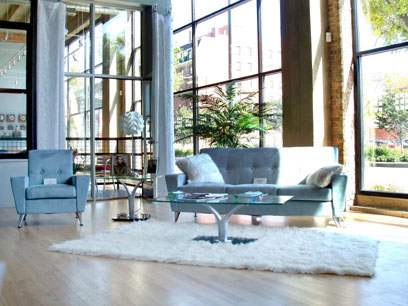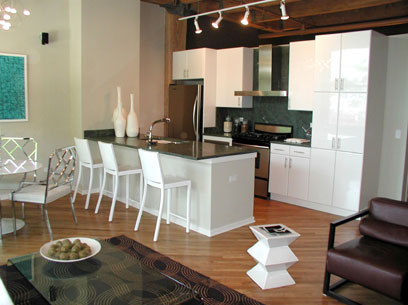Latest lofts offer new finishes in new neighborhoods
On one side of West Belmont Avenue just before Pulaski Road stands an old abandoned shoe factory with smashed windows and rusty window frames. Across the street, a stone’s throw away, is an old art deco warehouse that also has seen better days. In between lies a small retail hub in the blue-collar neighborhood of Avondale: a Polish American video store, a chicken ‘n’ ribs takeout, some coin laundries and a smoke-filled tavern.
Avondale, bounded roughly by Diversey Parkway, the Kennedy Expressway, Addison Street and Belmont Avenue, remains a quiet enclave, but change is in the air. The blue scaffolding and brightly colored real estate posters of lithe models striking yoga poses and lounging on expensive furniture are the most obvious indicators. In a year, the old Florsheim shoe factory will become the polished Shoemaker Lofts, 3926 W Belmont Ave, a 175-unit loft conversion with a fitness center, a rooftop deck and a business room. The abandoned warehouse down the block soon will be recast as Belmont Lofts, 4131 W Belmont Ave, a 54-unit loft project that will have its own fitness center and conference room.
The pioneering spirit of the loft market in Chicago is alive once again and coming soon to a non-gentrified neighborhood near you. Lofts no longer dominate the city market for new homes, as they did in the mid- to late ’90s, when every new project seemed to be a loft or loft hybrid, but loft building is robust.
At press time, New Homes tallied some 24 loft projects underway, many of them new kids on the block. Current developments range from the seven-unit boutique at 2105 W Concord Place, in Bucktown, to the massive 824-unit University Commons conversion, near the University of Illinois at Chicago campus. A couple of sizeable projects, such as Shoemaker Lofts, were moving closer to a sellout at press time after less than a year on the market.
Lofts are back and so is the adventurous spirit that marked their earliest days in the city.
The level of finishes and amenities in today’s projects is much higher than that of the first artists’ lofts, rough spaces that often included little beyond plumbing – sometimes not even that. But many of the latest projects are returning to the idea of loft as starter home, and they’re celebrating the creativity inherent in these distinctly urban spaces.
Loft locations spread
Rapidly rising prices have encouraged young homebuyers – the traditional loft dwellers – to shop beyond trendy lakefront neighborhoods, and loft developers suffering sticker shock at acquisition costs in central areas have moved in the same direction. Lofts are pushing into quiet neighborhoods to the northwest and southwest, including some that have never before seen residential lofts.
Some of the new projects, including Shoemaker Lofts, McKinley Park Lofts and Kissel Kar Lofts might be in unfamiliar areas, but that hasn’t stopped loft buyers, who have also, in a sense, returned to their roots.
“Loft dwellers have always been pioneers,” says architect and developer Pat FitzGerald, whose firm, FitzGerald Associates, designed Tandem Developers’ Bridgeport Station Lofts, a new-construction building with lofty features, at 3250 S Morgan St. “The first ones were artists. These days, it’s young professionals interested in an artistic lifestyle and a place to put their own imprint.”
For the artists who first made them into homes, lofts were about cheap, versatile space. Location wasn’t much of an issue for them, or for the first non-artist loft residents, who often moved to sparse industrial pockets for the perfect loft.
“Loft dwellers have always tended to be people who went for space and aesthetics regardless of the neighborhood,” FitzGerald says. “Location was a tertiary consideration.” And as loft buyers built equity and attracted retail and development to their neighborhoods, FitzGerald says, they paved the way for homebuyers to follow and for prices to rise.
Perhaps that’s what will happen at McKinley Park Lofts, 2323 W Pershing Road, in the Southwest Side neighborhood of the same name. The actual park in McKinley Park, located near the new lofts, boasts a lagoon, playgrounds and baseball diamonds.
The loft-driven gentrification push, for better or worse, is heading in other directions too.
“People are moving northwest and following the Blue Line (elevated train) to O’Hare,” notes developer Victor Ayala, of Blue Slate Properties. He’s referring to The College Lofts, 521 W Haddon Ave; Belmont Lofts, 4131 W Belmont Ave; Shoemaker Lofts, 3927 W Belmont Ave; and his own Elston Lofts, 3641 N Elston Ave, a new-construction project awaiting city approval in the area variously referred to as Belmont -Craigin and West Lake View.
To the south, there is Bridgeport Station Lofts, Tandem Developers’ new-construction follow-up to its sold-out Union Lofts project, a loft conversion next door. Though the new units are “loft-like” new construction, the earlier lofts sold well enough in blue-collar Bridgeport that Tandem continued the loft theme in designing and marketing Bridgeport Station. Kissel Kar Lofts, 2250 S Wabash Ave, pushes beyond the domain of South Loop lofts to an in-fill site on the Near South Side.
Heading north, you’ll find Kinetic Lofts at Rainbo Village, 4836 N Clark St, in Uptown, and North Beach Lofts, 1225 W Morse Ave, in Rogers Park.
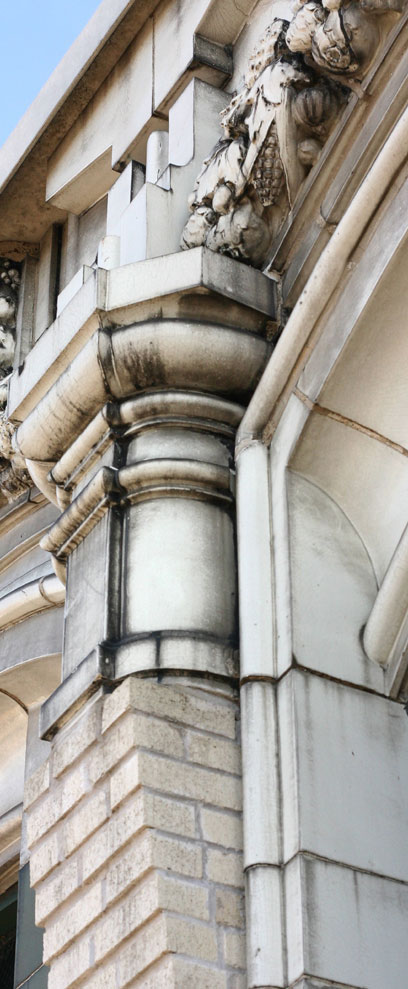 Developers also are finding the occasional opportunity to breathe life into an old masonry bank or a brick warehouse in centrally located neighborhoods that don’t often see loft projects these days. The Lofts at The Vic, 3150 N Sheffield Ave, has sold quickly in its prime Lake View location. The new loft development at 2105 W Concord Place sits in Bucktown, a once-grungy neighborhood pioneered, in part, by loft developers and now an upscale area of boutiques and restaurants.
Developers also are finding the occasional opportunity to breathe life into an old masonry bank or a brick warehouse in centrally located neighborhoods that don’t often see loft projects these days. The Lofts at The Vic, 3150 N Sheffield Ave, has sold quickly in its prime Lake View location. The new loft development at 2105 W Concord Place sits in Bucktown, a once-grungy neighborhood pioneered, in part, by loft developers and now an upscale area of boutiques and restaurants.
Lofts helped tame the West Loop in similar fashion, and now they’re pushing south of the neighborhood, aided by the expansion of the University of Illinois at Chicago campus. Loft developments, including University Station, 1500 S Blue Island Ave; Van Buren Lofts, 1224 W Van Buren St, and University Commons, 1000 W 15th St, are helping to fill in University Village and the surrounding areas.
Refined spaces
What do today’s loft buyers get for their money? Some developments in outlying neighborhoods offer comparatively affordable prices. At McKinley Park Lofts, they range from the $170s to the $360s for loft condos with 680 to 1,500 square feet. In more gentrified locations, of course, prices are higher. The intimate 2105 West Concord conversion, in Bucktown, has two-bedroom units with two to 2.5 baths and 1,200 to 2,600 square feet, priced from the $420s to the $520s.
The range of finishes and amenities is wide too. Buyers have traditionally loved lofts for their rawness, and developers have regarded them as the housing style most likely to fill a young buyer’s parents with horror. But just as other forms of housing are borrowing design elements such as high ceilings and open layouts from lofts, some lofts have been mimicking mom and dad’s house.
“People are shying away from half walls for bedrooms because sound carries throughout the whole place, and the loft market is going more traditional, with separated rooms, not half walls,” says Mike Battista, of Jameson Realty, which is marketing Stillpoint Development’s 2105 West Concord.
Even buyers of smaller lofts have high expectations, according to Malissa Welke, of Rubloff Residential, which is marketing The Tailor at Jackson Lofts.
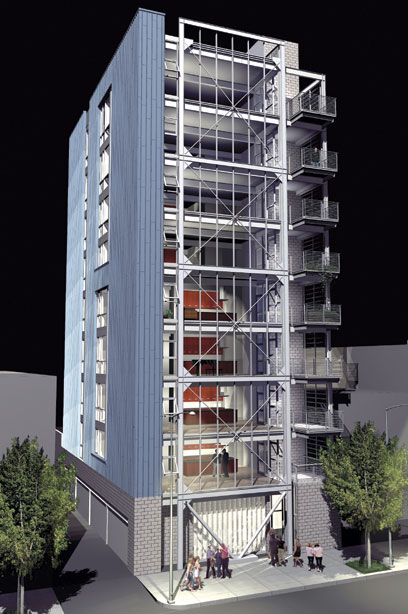 “It’s all about this nesting syndrome that’s been around for the last eight to 10 years,” Welke says. “People care more about their homes, but instead of wanting them to be larger, they want them to be more exquisite.”
“It’s all about this nesting syndrome that’s been around for the last eight to 10 years,” Welke says. “People care more about their homes, but instead of wanting them to be larger, they want them to be more exquisite.”
Developers know buyers are expecting luxury finishes and know that the average loft buyer, often young, hip and professional, will pay well for them even if the development isn’t in a “hot” location.
“We thought, let’s pretend this building is in River North – what would we do with it?” Michael Kelahan, director of marketing for Dubin Residential, says of the company’s Shoemaker Lofts, in Avondale. Many units are selling in the $300s and $400s because the building is loaded with amenities, and Dubin is selling a “lifestyle,” Kelehan says, complete with door staff, roof deck, meeting room, business center and fitness room.
“Now the writer, the graphic artist can meet people downstairs,” he says, referring to the on-site business facilities designed to aid those who work from home. Amenities at other projects, including 15th Street Lofts, 1503 S State St, and No. 10 Lofts, 1040 W Adams St, reflect the same live-work trend.
Ironically, Huron Street Lofts, a loft conversion at 225 W Huron St, in upscale River North, is taking the opposite approach. Aware that high home prices in the neighborhood have largely made it a province of empty nesters and move-up buyers, developer Huron Street Associates is offering a classic timber loft with “no frills” to appeal to first-time buyers. Those with bigger budgets can choose from available upgrades, says Huron Street Lofts’ sales manager, Todd Mullen.
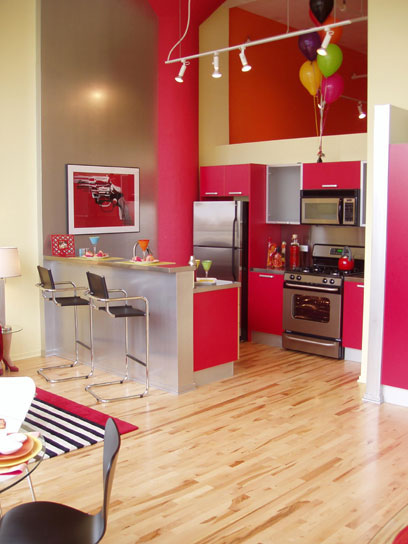 Mindful that their buyers might have the budgets for brand new conventional condos but don’t want cookie-cutter homes, developers are deviating from standard packages and offering creative finishes. Buyers can now find lofts with brightly colored feature walls and countertops of stained concrete, glass or quartz.
Mindful that their buyers might have the budgets for brand new conventional condos but don’t want cookie-cutter homes, developers are deviating from standard packages and offering creative finishes. Buyers can now find lofts with brightly colored feature walls and countertops of stained concrete, glass or quartz.
In an echo of a trend cropping up in New York and Washington, D.C., developer The Tenley Group is offering Grohe faucets and Snaidero cabinetry – high-end finishes found in luxury highrises – in its loft development, The Tailor at Jackson. The builder also enlisted Chicago design company “jamesthomas” to dream up three standard packages of finishes.
Playing on the textile theme inspired by the figure of a tailor carved into the loft’s facade, the developer hopes to lure buyers who have traditional tastes with a “wool” package of oak floors, granite counters and marble walls; a modernist “silk” package of maple floors, mosaic tiles and silestone counters (a durable quartz similar to soapstone); and for those with “in-between” tastes, a “cashmere” package of red oak floors, mosaic kitchen backsplash and silestone counters.
At its 2105 West Concord project, Stillpoint Development includes a $25,000 kitchen fit-out by Italian design company Arclinea and an airwave circulation tub as standard.
New-construction “lofts”
The market for new-construction “lofts” is steady too, with at least a dozen brand new projects marketing themselves as lofts, a testament to the genre’s continued popularity with buyers. Our definition of a loft is a building that was constructed for commercial purposes and later converted to residential use, so the new-construction developments aren’t true lofts in our book. But many recreate lofty features – high ceilings, airy spaces, open-plan living and exposed ductwork – and some buyers prefer them to conversions.
The Thrush Companies settled on a loft aesthetic for its 14-story glass, steel and concrete West Loop highrise 740 Fulton. The project offers condos with open floor plans, expansive windows and high ceilings. The ductwork and concrete ceilings are exposed, though the ceilings are painted for a more finished look. Blue Slate Properties is building several new condo buildings with exposed timber and other lofty features. These include Grand Timber Lofts, 500 N Damen Ave and University Crossing Lofts, 1610 S Halsted St
One reason exposed wood beams are rare in loft-style new-construction projects is that they’re expensive. Blue Slate’s Victor Ayala says his projects work because the higher cost of using timber is offset by the fact that he is building in areas where land is often priced 10 percent below property in neighborhoods closer to downtown.
Will “new lofts” replace conversions as developers run through the city’s finite stock of convertible commercial buildings? Experts say there are still plenty of buildings to mine.
Architect Pat FitzGerald points to industrial pockets along the north and south branches of the Chicago River as possible sites for future loft projects. The city has designated some of these industrial areas as Planned Manufacturing Districts in a bid to save jobs. FitzGerald contends that the industrial pockets the city is preserving often house only small-scale industries that don’t rely on the river and could be moved elsewhere, giving home buyers the opportunity of river frontage.
Developer Victor Ayala continues to keep his eye on the blue-collar neighborhoods of the city’s Northwest Side as well as South Shore.
“Neighborhoods in Chicago have been extremely diverse in nature and segregated economically,” he says, noting that young professionals are finding themselves priced out of Lincoln Park and Lake View. “More of the middle class is coming in and moving everywhere in Chicago…”

